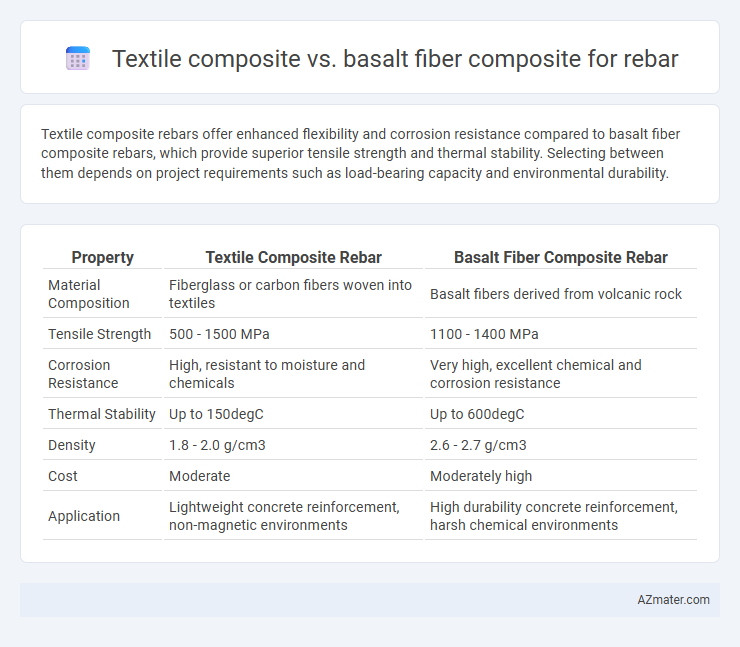Textile composite rebars offer enhanced flexibility and corrosion resistance compared to basalt fiber composite rebars, which provide superior tensile strength and thermal stability. Selecting between them depends on project requirements such as load-bearing capacity and environmental durability.
Table of Comparison
| Property | Textile Composite Rebar | Basalt Fiber Composite Rebar |
|---|---|---|
| Material Composition | Fiberglass or carbon fibers woven into textiles | Basalt fibers derived from volcanic rock |
| Tensile Strength | 500 - 1500 MPa | 1100 - 1400 MPa |
| Corrosion Resistance | High, resistant to moisture and chemicals | Very high, excellent chemical and corrosion resistance |
| Thermal Stability | Up to 150degC | Up to 600degC |
| Density | 1.8 - 2.0 g/cm3 | 2.6 - 2.7 g/cm3 |
| Cost | Moderate | Moderately high |
| Application | Lightweight concrete reinforcement, non-magnetic environments | High durability concrete reinforcement, harsh chemical environments |
Introduction to Composite Reinforcement Materials
Textile composites and basalt fiber composites represent advanced reinforcement materials widely used in construction for enhancing concrete durability. Textile composites typically utilize woven or stitched fiber fabrics embedded in a polymer matrix, offering high tensile strength and corrosion resistance. Basalt fiber composites are produced from volcanic rock fibers with superior thermal stability and alkali resistance, making them ideal for rebar applications in harsh environments.
Overview of Textile Composites for Rebar
Textile composites for rebar are engineered materials combining high-strength fibers such as carbon, glass, or basalt with polymer matrices to enhance corrosion resistance and mechanical performance in concrete reinforcement. Compared to basalt fiber composites, textile composites offer tailored fiber architectures like woven or knitted fabrics, enabling superior load distribution and improved bonding with concrete. These composites provide lightweight, non-corrosive alternatives to steel rebar, significantly increasing durability and lifespan in infrastructure applications.
Basalt Fiber Composites: Properties and Applications
Basalt fiber composites offer superior corrosion resistance, high tensile strength, and excellent thermal stability compared to traditional textile composites, making them ideal for rebar applications in harsh environments. Their non-corrosive nature enhances the durability and lifespan of reinforced concrete structures, especially in marine and chemical exposure settings. Basalt fiber rebar provides a cost-effective, eco-friendly alternative with enhanced mechanical properties for infrastructure projects requiring long-term reliability.
Mechanical Performance: Textile vs Basalt Fiber Rebar
Basalt fiber composite rebar exhibits higher tensile strength and excellent durability compared to textile composite rebar, making it more suitable for heavy-duty structural applications. Textile fiber rebars, typically made from carbon, glass, or aramid fibers, offer superior flexibility and corrosion resistance but generally have lower stiffness and tensile capacity than basalt fiber composites. The mechanical performance of basalt fiber rebar outperforms textile composites in resistance to alkali environments and load-bearing capacity, crucial for reinforced concrete longevity.
Durability and Corrosion Resistance Comparison
Textile composites and basalt fiber composites both offer enhanced durability and corrosion resistance for rebar applications, but basalt fiber composites exhibit superior resistance to alkaline environments and chemical degradation due to their natural mineral composition. Textile composites, often made from carbon or glass fibers embedded in polymer matrices, provide good mechanical performance but are more susceptible to moisture ingress and UV-related degradation over time. Basalt fiber composites maintain structural integrity and corrosion resistance in harsh environments, making them preferable for long-term use in reinforced concrete exposed to aggressive conditions.
Cost Analysis: Textile Composite vs Basalt Fiber Composite
Basalt fiber composite rebar typically offers a lower material cost compared to textile composites due to the more abundant raw basalt resources and simpler production processes. Textile composites, while potentially more expensive upfront, provide superior corrosion resistance and durability, which can reduce long-term maintenance expenses. Cost analysis must consider initial investment versus lifecycle savings, with basalt fiber composites favored for budget-sensitive projects and textile composites preferred for applications demanding heightened longevity.
Environmental Impact and Sustainability
Basalt fiber composites exhibit a lower environmental footprint compared to traditional textile composites due to basalt's natural abundance and energy-efficient production processes, which reduce carbon emissions significantly. Textile composites often rely on synthetic fibers derived from petrochemicals, contributing to higher environmental degradation and limited recyclability. Basalt fiber rebars enhance sustainability in construction by providing improved durability and resistance to corrosion, extending infrastructure lifespan and minimizing maintenance-related resource consumption.
Installation and Handling Considerations
Textile composites for rebar offer lightweight and flexible installation, allowing for easier handling and quicker placement on-site compared to basalt fiber composites. Basalt fiber composites provide superior durability and resistance to chemical corrosion, but their higher stiffness can require specialized equipment and increased labor during installation. Proper handling of both materials is crucial to maintain structural integrity, with textile composites being less prone to damage during transportation and basalt fiber composites demanding careful protection against impact and abrasion.
Industry Standards and Certification
Textile composite rebars adhere to ASTM D7565 and ACI 440.6 standards, ensuring high durability and corrosion resistance for civil engineering applications. Basalt fiber composites conform to ISO 11262 and European Technical Approval (ETA) certifications, emphasizing superior thermal stability and mechanical performance in harsh environments. Both materials meet stringent industry requirements for structural integrity, with textile composites excelling in flexibility and basalt composites preferred for fire resistance.
Future Trends and Innovations in Rebar Composites
Textile composites and basalt fiber composites for rebar are advancing through enhanced durability and sustainability features, with research emphasizing improved corrosion resistance and mechanical performance. Innovations such as hybrid reinforcement combining basalt fibers with high-performance textiles aim to optimize tensile strength and reduce carbon footprint in construction. Future trends indicate growing adoption of eco-friendly basalt fiber composites driven by regulatory pressures and the need for longer-lasting infrastructure materials.

Infographic: Textile composite vs Basalt fiber composite for Rebar
 azmater.com
azmater.com